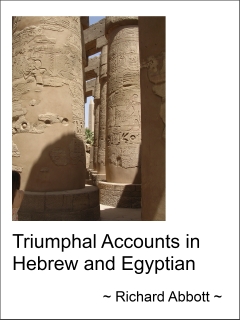The last blog entry looked at a simple example of a parallel couplet:
Joe cooked the main course
Mary made the sweet
They are called parallel because matching words are placed at the same place along each line – Joe and Mary, cooked and made, and main course and sweet. This time we’ll look at some variations of this simple pattern that poets in the ancient world used to give flexibility and interest to their work.
One way was to drop the verb from the second line, and use the “extra space” gained by doing that to add some description for one or other of the remaining words. The technical term for this is “verb deletion”.
So we could have
Joe cooked the main course
Mary the special sweet
or
Joe cooked the main course
Skilful Mary the sweet
In both cases the logic of parallel lines means that you do not really need the verb made on the second line – the pattern of the first line makes it obvious what is going on. The use of an adjective here means that something more of a background story can be hinted at. So the second of those examples suggests that the two of them divided up the jobs because Mary was particularly adept at desserts. But if instead we said:
Joe cooked the main course
Time-pressed Mary the sweet
then the background issue is not that of skill, but of opportunity.
Perhaps the most important ancient world variation on the parallel couplet is called chiasmus, from a Greek word with the broad meaning of crossing over. To do this, we reverse the order of the second line:
Joe cooked the main course
The sweet was made by Mary
Now, instead of corresponding parts being in the same place on their lines, they swap over. Joe is at the start of the first line, Mary at the end of the second. Main course ends the first line, sweet starts the second. If you were to join the matching pieces of each half of the couplet with straight lines, then a simple parallel couplet would have these lines going vertically down the screen or page. With chiasmus, the lines form an X on the page or screen, the Greek letter chi (as in chi-asmus).
As well as giving some variation for the sake of interest, and avoiding an endless series of parallel couplets, chiasmus also gives the poet a chance to give some overall shape to the poem. It is quite common to have a couplet using chiasmus at the centre of a poem, or at some other logical place where there is a turning point of mood or action. Perhaps if we were to write the rest of the Joe and Mary poem, the first half might be all about Joe, and the second half all about Mary, with the chiasmus helping to make the changeover. In this way, the poet can also indicate more serious changes, such as from defeat to victory, sin to repentance, despair to hope, and so on. It can be a very compact and versatile way to indicate a change of situation. Sadly, many modern translations of the Hebrew Bible and other ancient poems do not keep the particular pattern of chiasmus, but change the word order back into direct parallel lines.
In a Milk and Honeyed Land includes some fragments of poetry using these variations. Both kinds can be found in the oath that Damariel swears to Nepheret shortly after they set out towards Kephrath. He starts with chiasmus:
Listen, all you gods of the nations,
in the divine assembly take note.
He then moves on to verb deletion, omitting the verb in the second half of the following couplet and lengthening the description of himself to a short phrase:
Record the words of Damariel,
the oath of the son of Yeresheth.
He completes the verse part of his promise with another chiasmus:
Nepheret’s freedom was bought for her pleasure,
and for her own delight has she been released.
Of course, these words were not supposed to be carefully crafted and designed poetry, but part of a promise he made up on the spur of the moment outside Gedjet (modern Gaza). I have assumed that the habits of speech and rhythm that he knew in his “professional” life would spill over into parts of conversation that he might consider to be formal, such as this promise.
There are actually a great many examples of chiasmus scattered through the book, as it is a literary device that I am very fond of. Some, like the examples above, are embedded in a poem or portion of direct speech, but many others can be found in the descriptive text. Still others can be found on a larger scale again. See how many examples you can find where chiasmus is used to steer and shape the plot.
In a Milk and Honeyed Land may be purchased online – see http://www.kephrath.com/WhereToBuy.aspx for a list of vendors.
Or ask your own local bookshop to obtain a copy – ask by title or else ISBN number:
Paperback: 978-1-4669-2166-5
Hardcover: 978-1-4669-2167-2
e-Book: 978-1-4669-2165-8

